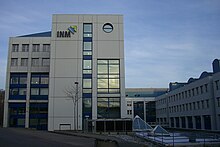Leibniz Institute for New Materials
| INM - Leibniz Institute for New Materials | |
|---|---|
 Leibniz Institute for New Materials |
|
| Category: | research Institute |
| Carrier: | legally independent |
| Legal form of the carrier: | gGmbH |
| Membership: | Leibniz Association |
| Facility location: | Saarbrücken |
| Type of research: | Basic research |
| Subjects: | Physics , chemistry , biology , materials science , engineering |
| Areas of expertise: | Materials research , nanotechnology , interface materials , bio interfaces , nanocomposite technology |
| Basic funding: | Federal government (50%), states (50%) |
| Management: | Eduard Arzt (Scientific Director and Chairman of the Management Board), Arànzazu del Campo (Scientific Director) and Günter Weber (Commercial Director) |
| Employee: | 266 |
| Homepage: | www.leibniz-inm.de |
The INM - Leibniz Institute for New Materials gGmbH is a non-university research institute and a member of the Leibniz Association . It conducts application-oriented basic research in the field of materials science, whereby physical, chemical, biological and engineering aspects are also included. The institute is a non-profit GmbH ( gGmbH ) in Saarbrücken based on the campus of Saarland University .
history
The “Institute for New Materials” (INM) was founded in 1987 in the form of a non-profit limited liability company, initially under the sole responsibility of the state under the direction of Herbert Gleiter . In 1990 Helmut K. Schmidt took over the management of the institute, which he headed until 2005. Under his leadership, the INM focused particularly on chemical nanotechnology.
In 2005, when Michael Veith and Jochen Flackus took over management, a phase of reorientation began for the institute. On October 1, 2007 Eduard Arzt was appointed Scientific Director and Chairman of the Management Board. A far-reaching realignment of the INM was undertaken under his leadership. In addition to chemical nanotechnology, interface materials and materials in biology were another research focus. In 2010 Roland Rolles took over the commercial management, which passed to Günter Weber in 2014. In 2015 Arànzazu del Campo was appointed second Scientific Director.
Saarland University has been a partner since 1991 with a 51% share. Since the early 1990s, projects financed by the BMBF and industry have increasingly been carried out; From the mid-1990s, a technology transfer was established . A total of eleven spin-offs were founded between 1995 and 2004. In connection with the reorientation, basic research was finally strengthened from 2007 onwards.
In a recommendation by the Science Council , the institute was classified as a research facility of supraregional importance and, as a result, included in the so-called Blue List on January 1, 1999, and thus included in the federal-state funding. In October 2003 the name was changed to “Leibniz Institute for New Materials gGmbH”.
tasks
The INM works in the field of new materials. It conducts basic and application-oriented material research, which ranges from the molecular preliminary stages to pilot production. Thematic priorities are reflected in the division into the research fields of nanocomposite technology, interface materials and bio interfaces. From a chemical, physical and biological point of view, it develops nanostructured materials, researches their properties and explores possible applications in industrial cooperations. The INM works closely with Saarland University, national and international research institutes and companies worldwide.
The detailed research focus of the INM can be seen in the department structure below.
organization
The INM is led by two scientific managing directors and one commercial managing director; a scientific managing director is the chairman of the management board. The scientific area of INM is currently divided into eleven program areas and two junior research groups, which are divided into three research fields and one cross-sectional area:
Nanocomposite technology
- Nanomers
- Optical materials
- Structure formation
Interface materials
- Energy materials
- Functional microstructures
- Nanotribology
- Innovative electron microscopy
Bio-interfaces
- Dynamic biomaterials
- Switchable microfluidics
- Cytoskeletal fibers
- Nano cell interactions
Cross-sectional area Innovation Center INM
In addition to the program areas, the INM maintains service areas that support scientific work, particularly in the areas of analysis and characterization, the design and construction of specific devices and equipment, and a special scientific library.
Personnel and Financing
The INM employs around 266 people, including around 88 scientists and around 38 doctoral students (as of the end of 2018). As an institution of the Leibniz Association, half of the basic funding for the INM is provided by the federal government and the other half. The federal portion is borne by the Federal Ministry of Education and Research (BMBF), the state portion for the most part by Saarland; the rest of the country share is divided among all countries according to the Königstein key. Overall, the INM had an annual budget of around 24.82 million euros in the 2018 budget year.
Web links
- Homepage of the INM - Leibniz Institute for New Materials
- Homepage of the Leibniz Association
- Literature on the Leibniz Institute for New Materials in the Saarland Bibliography
Individual evidence
- ↑ Library Blog - INM - Bibliothek ( Memento of the original from March 12, 2017 in the Internet Archive ) Info: The archive link was inserted automatically and has not yet been checked. Please check the original and archive link according to the instructions and then remove this notice. accessed on March 11, 2017.
- ↑ leibniz-inm.de/historie ( Memento of the original from June 7, 2016 in the Internet Archive ) Info: The archive link has been inserted automatically and has not yet been checked. Please check the original and archive link according to the instructions and then remove this notice. - official website. Retrieved May 27, 2015.
Coordinates: 49 ° 15 ′ 24 ″ N , 7 ° 2 ′ 24 ″ E
